
Acronychia acidula, commonly known as lemon aspen or lemon wood, is a species of small to medium-sized rainforest tree that is endemic to Queensland. It has simple, elliptical leaves, small groups of flowers in leaf axils and more or less spherical fruit. The aromatic and acidic fruit is harvested as a bushfood.
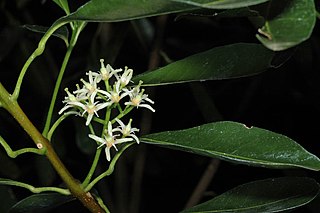
Acronychia oblongifolia, commonly known as white aspen or yellow wood, is a species of shrub to medium-sized rainforest tree of the citrus family, Rutaceae and is endemic to eastern Australia. It has mostly simple, egg-shaped leaves with the narrower end towards the base, small groups of creamy-white flowers and fleshy, more or less spherical, edible fruit.

Melicope elleryana, commonly known as pink flowered doughwood, pink evodia, corkwood, or saruwa, is a species of rainforest shrub or tree in the family Rutaceae, and is native to New Guinea, parts of eastern Indonesia, the Solomon Islands and northern Australia. It has trifoliate leaves and pink to white, bisexual flowers arranged in panicles in leaf axils.

Melicope micrococca, commonly known as hairy-leaved doughwood or white euodia, is a species of shrub or slender tree in the family Rutaceae and is endemic to eastern Australia. It has trifoliate leaves and white flowers borne in panicles in leaf axils.

Acronychia octandra, commonly known as doughwood, silver birch or soapwood, is a species of rainforest tree that is endemic to eastern coastal areas of Australia. It has mostly trifoliate leaves with elliptic to egg-shaped leaflets, greenish-white flowers arranged in groups in leaf axils and fleshy fruit of four carpels fused at the base.

Acronychia wilcoxiana, commonly known as silver aspen, doughwood, snowwood or mushyberry, is a species of small rainforest tree that is endemic to eastern Australia. It has simple, elliptical to egg-shaped leaves with the narrower end towards the base, relatively large groups of whitish flowers in leaf axils and broadly oval to more or less spherical, white fruit.

Acronychia pubescens, commonly known as hairy acronychia or hairy aspen, is a species of tall shrub or small tree that is endemic to eastern Australia. It usually has trifoliate leaves, rarely simple leaves, groups of whitish flowers in leaf axils and creamy to yellowish, elliptical to spherical fruit.
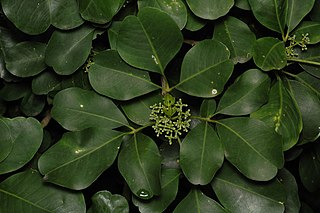
Melicope polybotrya is a species of shrub or small tree in the family Rutaceae and is endemic to Lord Howe Island. It has trifoliate leaves and green flowers borne in short panicles in leaf axils.

Melicope bonwickii, commonly known as the yellow evodia or yellow corkwood, is a species of tree in the family Rutaceae and is native to Java and the Philippines, and southward to New Guinea and north-eastern Australia. It has trifoliate leaves and small pink flowers borne in panicles in leaf axils.

Bosistoa medicinalis, commonly known as the northern towra or Eumundi bosistoa, is a species of small to medium-sized rainforest tree that is endemic to Queensland. It has simple and pinnate leaves with two or three leaflets and panicles of small white flowers.
Acronychia aberrans, commonly known as acid berry, lemon aspen, plasticine tree or plasticene aspen, is a species of medium-sized rainforest tree that is endemic to north-eastern Queensland. It has simple leaves on stems that are more or less square in cross-section, flowers in small groups in leaf axils and fleshy, more or less spherical fruit.

Acronychia acuminata, commonly known as Thornton aspen, is a species of shrub or small rainforest tree that is endemic to north-eastern Queensland. It has simple leaves on stems that are more or cylindrical, flowers in small groups in leaf axils and fleshy, oval to spherical fruit.
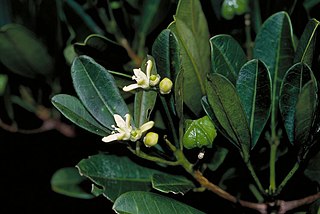
Acronychia chooreechillum, commonly known as mountain aspen, is a species of shrub or small rainforest tree that is endemic to north-eastern Queensland. It has mostly trifoliate leaves with elliptic to egg-shaped leaflets on stems that are more or less cylindrical, flowers in small groups in leaf axils and fleshy, egg-shaped or elliptical fruit.

Acronychia imperforata, commonly known as Logan apple, Fraser Island apple, or green tree, is a species of rainforest shrub or small tree that is endemic to north-eastern Australia. It has simple, elliptical to egg-shaped leaves, small groups of yellowish or creamy white flowers and fleshy spherical to oval fruit.

Acronychia vestita, commonly known as white aspen, lemon aspen, hairy aspen or fuzzy lemon aspen, is a species of rainforest tree that is endemic to Queensland. It has simple, elliptic to egg-shaped leaves with the narrower end towards the base, flowers arranged in relatively large groups, mostly in leaf axils and fleshy, pear-shaped to more or less spherical fruit.

Bouchardatia neurococca, commonly known as union nut, is a species of small rainforest tree that is endemic to eastern Australia. It has pinnate leaves with three or five narrow elliptical leaflets, white flowers arranged in panicles, and oval follicles.
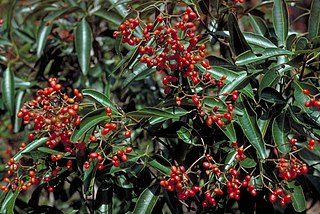
Dinosperma is a genus of plant containing the single species Dinosperma erythrococcum, commonly known as tingletongue, clubwood or nutmeg, and is endemic to north-eastern Australia. It is a tree usually with trifoliate leaves arranged in opposite pairs, the leaflets lance-shaped to oblong, and panicles of small white flowers, later bright orange to red, slightly fleshy follicles containing shiny, bluish black seeds.

Medicosma fareana, commonly known as white aspen, is a species of rainforest small tree in the family Rutaceae and is endemic to north Queensland. It has elliptical leaves and white or cream-coloured flowers borne singly or in small groups in leaf axils.

Melicope vitiflora, commonly known as northern evodia, fishpoison wood, leatherjacket or leatherwood, is a species of shrub or small tree in the family Rutaceae and is native to north-eastern Australia and New Guinea. It has trifoliate leaves and green to white or cream-coloured flowers borne in panicles in leaf axils.
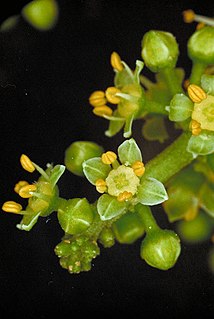
Melicope xanthoxyloides is a species of small tree in the family Rutaceae and is native to New Guinea and Queensland. It has trifoliate leaves and small green to yellow or cream-coloured flowers arranged in panicles in leaf axils.




















